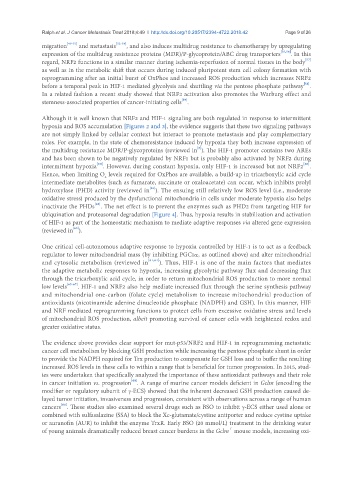Page 589 - Read Online
P. 589
Ralph et al. J Cancer Metastasis Treat 2018;4:49 I http://dx.doi.org/10.20517/2394-4722.2018.42 Page 9 of 26
migration [49-51] and metastasis [52-54] , and also induces multidrug resistance to chemotherapy by upregulating
expression of the multidrug resistance proteins (MDR)/P-glycoprotein/ABC drug transporters [55,56] . In this
[57]
regard, NRF2 functions in a similar manner during ischemia-reperfusion of normal tissues in the body
as well as in the metabolic shift that occurs during induced pluripotent stem cell colony formation with
reprogramming after an initial burst of OxPhos and increased ROS production which increases NRF2
[58]
before a temporal peak in HIF-1 mediated glycolysis and shuttling via the pentose phosphate pathway .
In a related fashion a recent study showed that NRF2 activation also promotes the Warburg effect and
[59]
stemness-associated properties of cancer-initiating cells .
Although it is well known that NRF2 and HIF-1 signaling are both regulated in response to intermittent
hypoxia and ROS accumulation [Figures 2 and 3], the evidence suggests that these two signaling pathways
are not simply linked by cellular context but interact to promote metastasis and play complementary
roles. For example, in the state of chemoresistance induced by hypoxia they both increase expression of
[8]
the multidrug resistance MDR/P-glycoproteins (reviewed in ). The HIF-1 promoter contains two AREs
and has been shown to be negatively regulated by NRF1 but is probably also activated by NRF2 during
[60]
[60]
intermittent hypoxia . However, during constant hypoxia, only HIF-1 is increased but not NRF2 .
Hence, when limiting O levels required for OxPhos are available, a build-up in tricarboxylic acid cycle
2
intermediate metabolites (such as fumarate, succinate or oxaloacetate) can occur, which inhibits prolyl
[61]
hydroxylase (PHD) activity (reviewed in ). The ensuing still relatively low ROS level (i.e., moderate
oxidative stress) produced by the dysfunctional mitochondria in cells under moderate hypoxia also helps
[62]
inactivate the PHDs . The net effect is to prevent the enzymes such as PHD2 from targeting HIF for
ubiquination and proteasomal degradation [Figure 4]. Thus, hypoxia results in stabilization and activation
of HIF-1 as part of the homeostatic mechanism to mediate adaptive responses via altered gene expression
[63]
(reviewed in ).
One critical cell-autonomous adaptive response to hypoxia controlled by HIF-1 is to act as a feedback
regulator to lower mitochondrial mass (by inhibiting PGC1α, as outlined above) and alter mitochondrial
and cytosolic metabolism (reviewed in [61,64] ). Thus, HIF-1 is one of the main factors that mediates
the adaptive metabolic responses to hypoxia, increasing glycolytic pathway flux and decreasing flux
through the tricarboxylic acid cycle, in order to return mitochondrial ROS production to more normal
low levels [65-67] . HIF-1 and NRF2 also help mediate increased flux through the serine synthesis pathway
and mitochondrial one-carbon (folate cycle) metabolism to increase mitochondrial production of
antioxidants (nicotinamide adenine dinucleotide phosphate (NADPH) and GSH). In this manner, HIF
and NRF mediated reprogramming functions to protect cells from excessive oxidative stress and levels
of mitochondrial ROS production, albeit promoting survival of cancer cells with heightened redox and
greater oxidative status.
The evidence above provides clear support for mut-p53/NRF2 and HIF-1 in reprogramming metastatic
cancer cell metabolism by blocking GSH production while increasing the pentose phosphate shunt in order
to provide the NADPH required for Trx production to compensate for GSH loss and to buffer the resulting
increased ROS levels in these cells to within a range that is beneficial for tumor progression. In 2015, stud-
ies were undertaken that specifically analyzed the importance of these antioxidant pathways and their role
[68]
in cancer initiation vs. progression . A range of murine cancer models deficient in Gclm (encoding the
modifier or regulatory subunit of γ-ECS) showed that the inherent decreased GSH production caused de-
layed tumor initiation, invasiveness and progression, consistent with observations across a range of human
[68]
cancers . These studies also examined several drugs such as BSO to inhibit γ-ECS either used alone or
combined with sulfasalazine (SSA) to block the Xc-glutamate/cystine antiporter and reduce cystine uptake
or auranofin (AUR) to inhibit the enzyme TrxR. Early BSO (20 mmol/L) treatment in the drinking water
-/-
of young animals dramatically reduced breast cancer burdens in the Gclm mouse models, increasing oxi-

